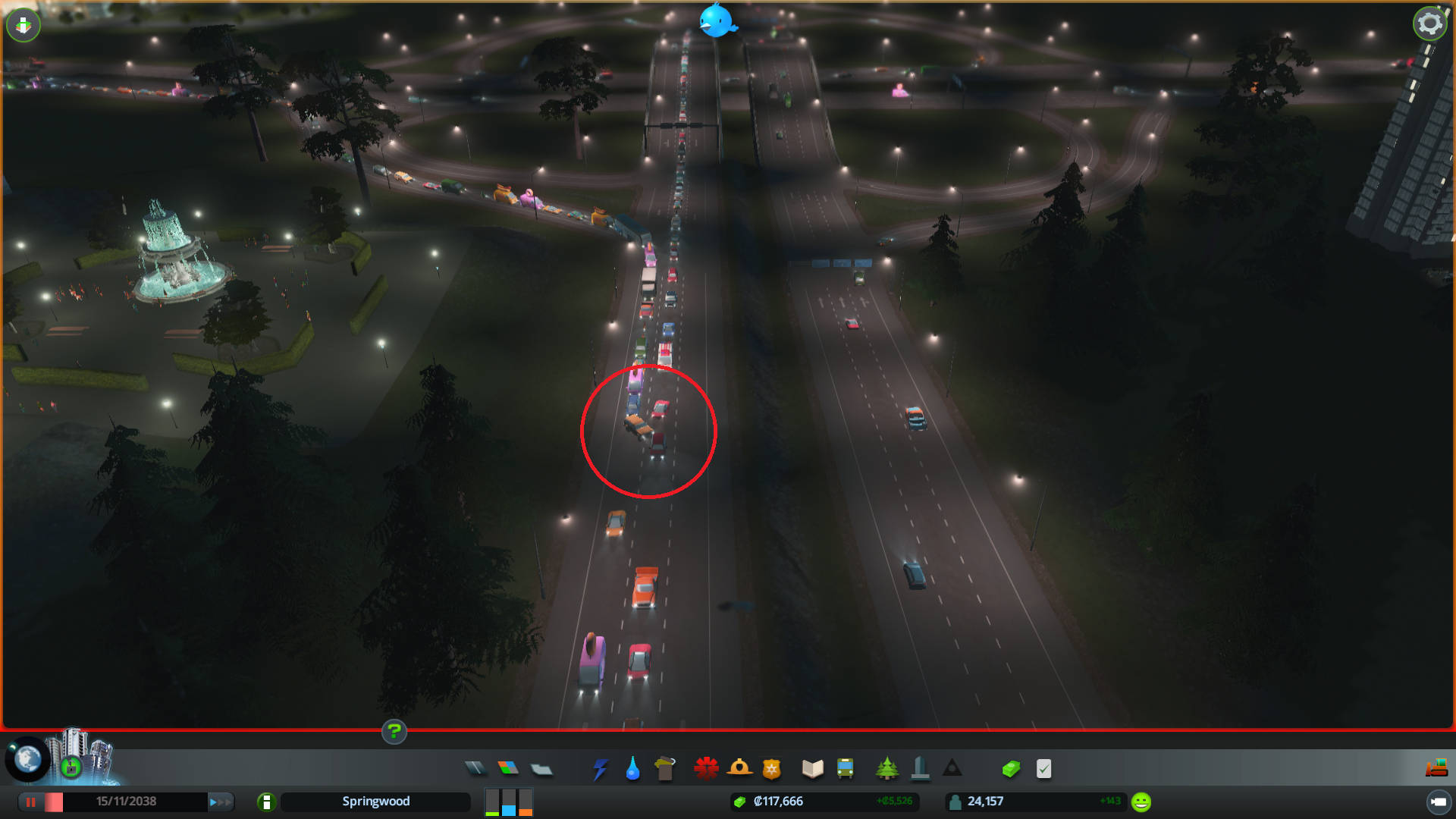This is default cloverleaf intersection. It works fine till certain moment. Is there any way to improve it?
-
1Is there an on or off ramp just off the screen? Cars move over to avoid blocking them, which may cause this behavior.– JMRCommented Oct 12, 2015 at 21:37
-
No ramps. Off screen - to the left is industrial area, on top is old low density residential and commercial areas and on bottom is new high density residential and commercial. And this is not only one way. I have plenty alternate roads. I think main traffic problem in this game is that "path-finding" do not take traffic density as "weight" in calculation. Cars always go shortest way and got stuck.– Alexander IvanovCommented Oct 13, 2015 at 7:04
-
This is actually not true. The vehicles DO take traffic congestion into account when generating paths. They are calculating and figuring that that particular route is STILL their best option despite the congestion. The screenshot appears to show what is called "weaving". Something is causing the cars merging in to want to change immediately to the middle lane. To be able to tell what, I'd need to see more of what you've built.– JMRCommented Oct 14, 2015 at 14:54
2 Answers
If that's your main channel from the Industrial area leading to the Commercial, it's wise to either make a separate highway for the industry (either underground or overground), or upgrade that highway off-ramp to a three lane highway. (Sometimes it helps, sometimes it just pushes the congestion farther down the highway).
Yes, in fact there are many ways in which 4-way highway intersections can be improved or upgraded.
You can take a look at what is done in real life. The accuracy of the traffic model in Skylines is such that often solutions that work well in the real world, work well there too. Most commonly, in order to improve the throughput of a cloverleaf these are done:
1) Conversion to a partial cloverleaf / partial stack interchange.
When a left turn is congested, this can help. In an standard cloverleaf, traffic is first added, then removed. If you convert two of the left turns by removing them and instead having them pass over the structure (making it a 3-level interchange), you can improve the flow. Unfortunately, this method won't help in your particular case.
2) Add slip roads.
Many cloverleafs in the real world use this method, for it does not require modifying the elevated (or tunnelled) parts, which are the most expensive bits to build or change in an intersection. (In C:SL you will have to modify these parts though, as you can't change the lane configuration on the bridge) What you do is the following (assuming a 3-lane x 3-lane highway cloverleaf):
- Split up both highways into 2x2 + 2x2, so your lane config is
LL|LL|RR|RR. - Expand the outer 2-lane highway to 3-lane.
- Replace the off-ramps with 3-lane to 2-lane splits, then 2-lane to 1-lane splits for the left turns.
- Put a higher speed limit on the center roadway to make sure through traffic uses that instead of the slip roads.
3) Modify the main branch
If your cloverleaf has more right-bound traffic than straight traffic, you could replace the intersection with one where both highways turn right. In this case, the easiest way to do it is to move the highways so that they both make a parallel S-bend, causing them to run straight, then put a parallel highway interchange to connect them.
4) Weave intersection
This is a variation on the intersection from the previous paragraph.
Alternatively, you can 'weave' the highways for a smaller footprint. Raise or lower the right part of the left highway, interchange it with the left part of the right highway. Then add splits of 3+3 -> 6 lanes and back to both.
Note that this type of intersection does have weaving like a cloverleaf, but on different lanes. Make sure to never have a situation where traffic flow is higher for the cars that have to change roads than the cars that go straight (this will bottleneck this type of intersection).
Images in this post courtesy of Wikipedia. Also see this article.





